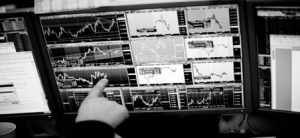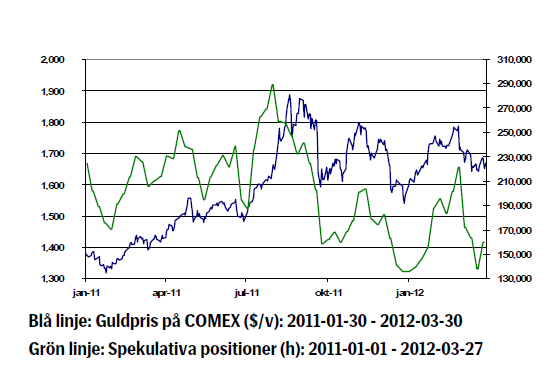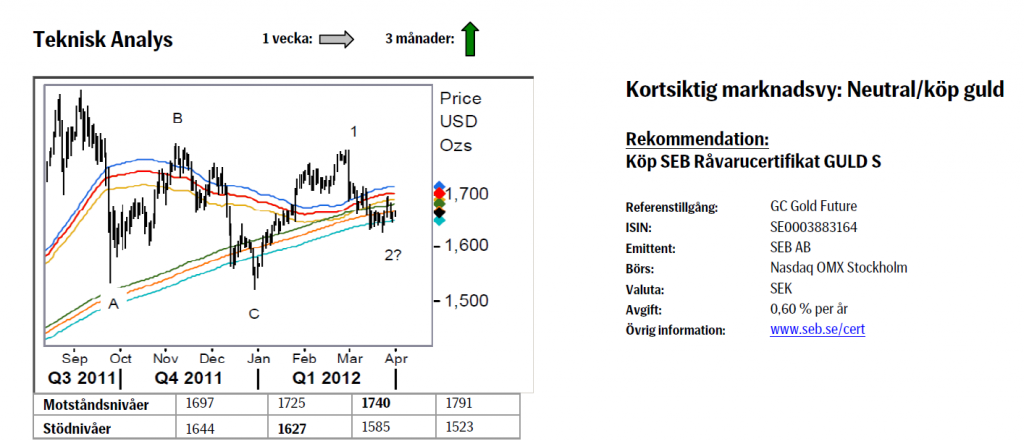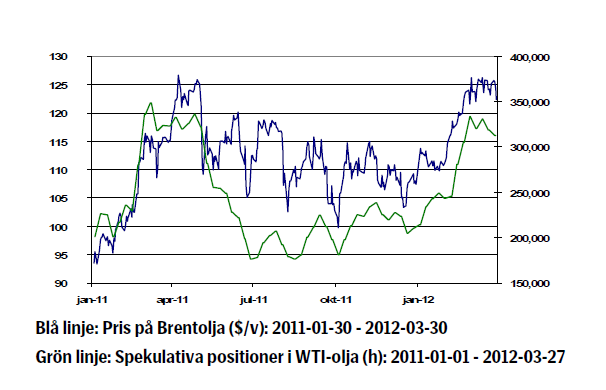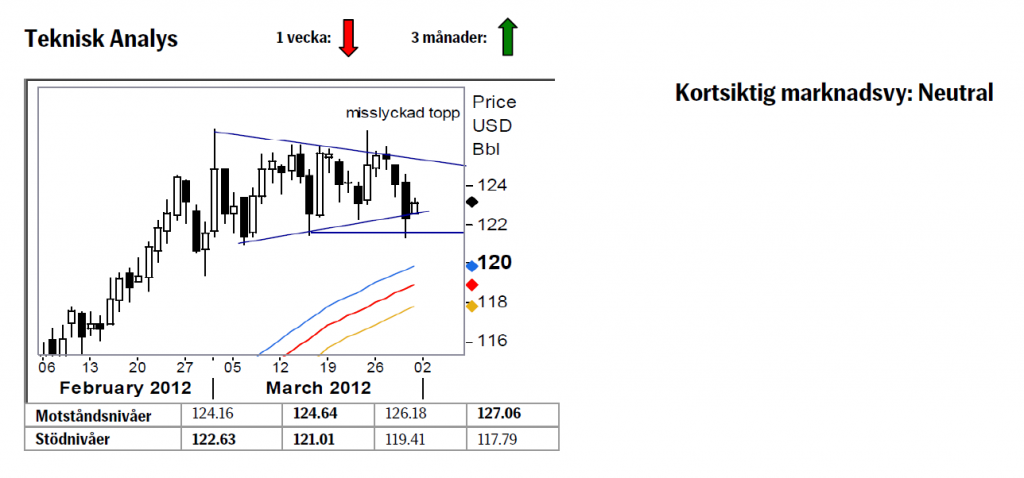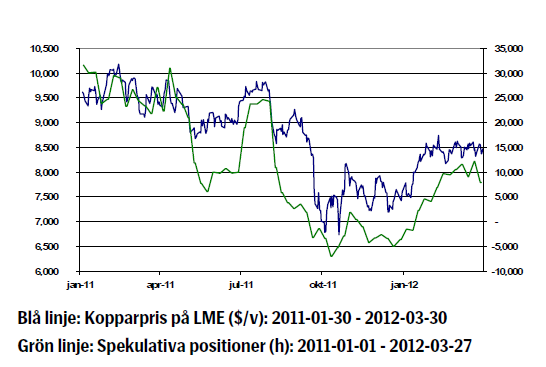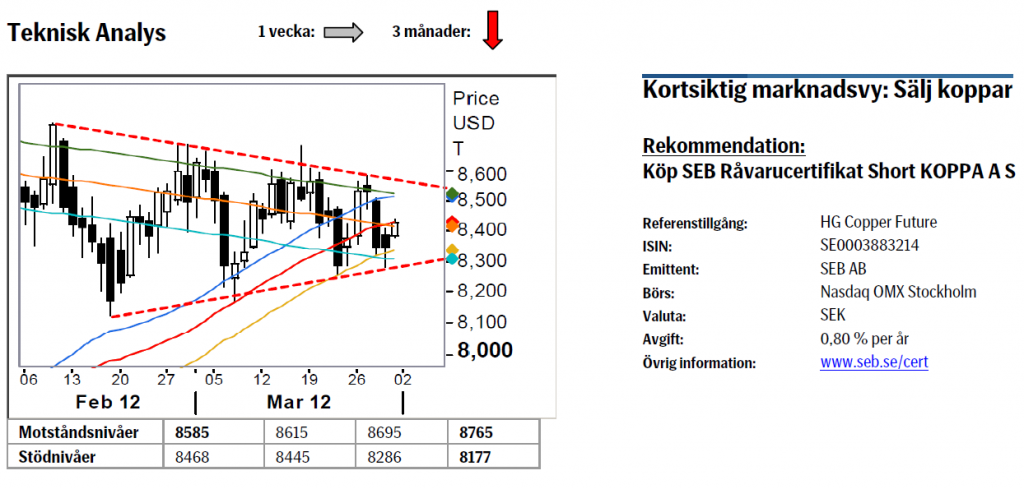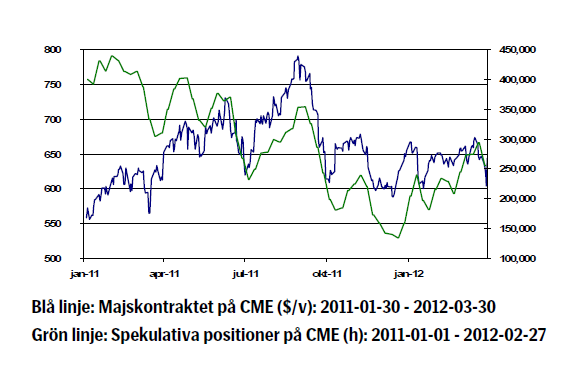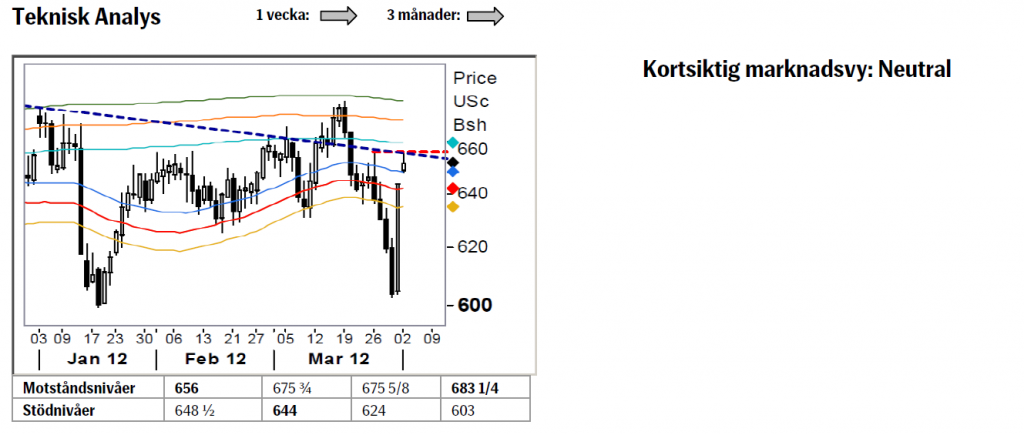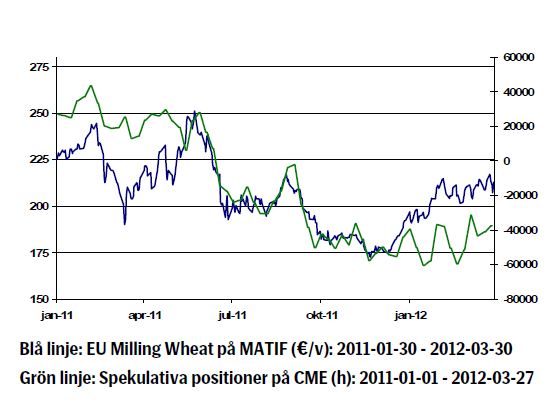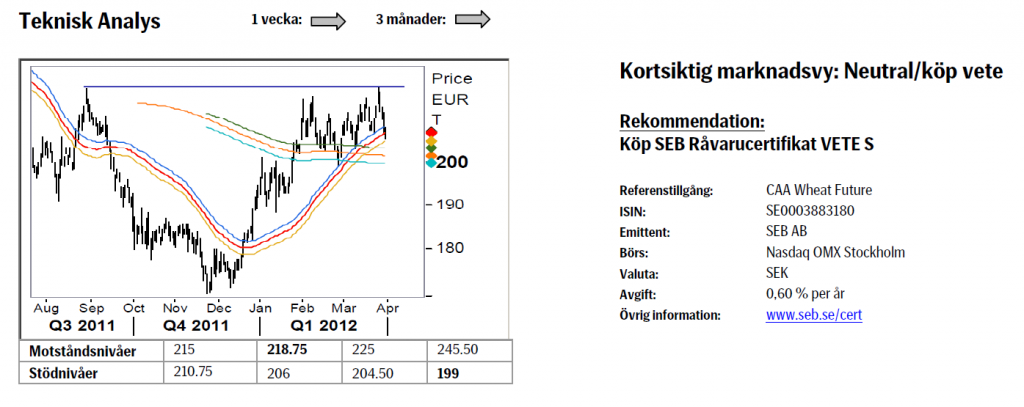Analys
SEB – Råvarukommentarer vecka 14 2012
Sammanfattning: Föregående vecka
- Energi: -2,68 %
UBS Bloomberg CMCI Energy TR Index
- Ädelmetaller: +0,47 %
UBS Bloomberg CMCI Precious Metals TR Index
- Industrimetaller: -0,37 %
UBS Bloomberg CMCI Industrial Metals TR Index
- Jordbruk: +0,40 %
UBS Bloomberg CMCI Agriculture TR Index
Kortsiktig marknadsvy:
- Guld: Neutral/köp
- Olja: Neutral
- Koppar: Sälj
- Majs: Neutral
- Vete: Neutral
Guld
- Ben Bernanke nämnde under början av veckan ett eventuellt fortsatt behov av stimulansåtgärder, detta bland annat för att stödja den amerikanska arbetsmarknaden. Guldet rusade upp mot 1700 USD på uttalandet, detta då marknaden tolkade budskapet som en möjlighet till en ytterligare våg av kvantitativa lättnader i USA.
- Den landsomfattande strejk bland Indiens 300 000 juvelerare som vi nämnde förra veckan visade sig göra ett visst avtryck i marknaden. Exempelvis lyckades denna aktion trycka ned priset igen under veckan, detta då landet är världens största köpare av fysiskt guld. Bakgrunden till strejken är en kraftigt ökad importskatt på guld. I fredags meddelade dock representanter för juvelerarna att man planerar att avbryta strejken, detta då den ökade skattesatsen verkar bli skjuten på framtiden.
- Efter en negativ utveckling de senaste veckorna börjar nu investerarna återigen gå in i guld. Den generella riskviljan får investerarna att gå ur trygga valutor (som den amerikanska dollarn) och in i exempelvis aktier och råvaror istället. Med denna utveckling ökar inflödet i guld och ger således stöd åt priset. Till skillnad från andra metaller får guld anses vara en rent finansiell eller smyckesrelaterad råvara.
- Enligt Bloomberg har försäljningen av både guld- och silvermynt i USA ökat igen, vilket visar på ett allmänt ökat intresse för guld som sparform.
- Teknisk Analys: Egentligen har inte speciellt mycket skett under innevarande vecka. Ett försök upp emot 1700 området blockerades och marknaden föll tillbaka ned mot den nedre delen av medelvärdesbanden. Vi fortsätter alltså vårt sökande efter mer bevis för en fortsättning av den långsiktiga uppåttrenden. Framgent gäller fortfarande att 1725/40 utgör bekräftelsepunkten för uppgång samt att vi däröver kan spika igen dörren till källaren.
Olja
- Både oljepriset och bolag inom oljesektorn gick under måndagen starkt på rapportering om att omvärldens sanktioner mot Iran kommer att minska landets råoljeexport med flera hundratusen fat per dag.
- Under större delen av förra veckan föll oljepriset, detta på politiska utspel om ökat utbud samt indikationer om en svag global tillväxt. Totalt sett föll priset tillbaka med nästan 1,8 procent.
- De politiska utspelen kommer från representanter för regeringarna ibland annat USA, Storbritannien och Frankrike, vilka uttryckt intresse för att släppa strategiska oljelager. Det spekuleras i dagsläget kring Obamas och Sarkozys möjligheter att bli omvalda med ett oljepris runt 125 USD per fat och att detta driver dem till att försöka få ner priset. Viktigt att känna till är att energiorganet IEA (International Energy Agency) är de som rekommenderar om sådana åtgärder och det förefaller för närvarande inte troligt att de kommer att göra det den närmaste tiden.
- På efterfrågesidan finns det i nuläget många frågetecken kring den egentliga hälsan för den globala ekonomin. I Kina, som till stor del agerat draglok de senaste åren, förekommer en kontrollerad men omfattande inbromsning. USA har de senaste månaderna visat sig vara ett starkt kort, men kvaliteten i återhämtningen på bland annat arbetsmarknaden kan ifrågasättas. I Europa är nu Spanien i fokus, vilket skapar oro avseende hela Eurozonen.
- Teknisk Analys: Sannolikheten för att vi kommer att göra rycket upp emot 129/131 området har fallit kraftigt efter förra fredagens falska brott upp ur triangeln. Dessutom har vi handlat under, temporärt men dock under 121.50, vilket ytterligare drar ned möjligheten till en snar uppgång. Detta faktum gör att vi för nästkommande vecka snarare har fokus på nedsidan än det omvända.
Koppar
- På måndagen steg kopparpriset rejält, detta bland annat på spekulationer om minskad metallproduktion som en effekt av de höga energipriserna.
- Under förra veckan kom sedan ovanligt svaga siffror avseende de aggregerade industrivinsterna för kinesiska bolag. Från att i drygt två års tid ha legat på en årlig positiv tillväxttakt över 20 procent justerades siffran ned så att vinsttillväxten nu istället är negativ. Man får i regel ta officiella siffror från Kina med en nypa salt, men likväl kan denna typ av data vara sådan att den trycker ned priset rejält på kort sikt.
- Enligt Bloomberg stiger för närvarande kopparlagren i både London och Shanghai. Den kinesiska inbromsningen verkar slå hårt mot efterfrågan på fysisk koppar och risken för en kraftig korrektion får anses vara överhängande.
- Sedan början av februari har de andra industrimetallerna gått ner med mellan 5–15 procent, detta samtidigt som kopparpriset på LME gått upp med nästan 2 procent.
- Enligt en undersökning från Bloomberg förväntar sig 11 av 25 tillfrågade analytiker att kopparpriset ska gå ned denna vecka. Samtidigt tror 7 analytiker på en uppgång och 7 är neutrala. Detta är den största andelen med en negativ marknadsutsikt sedan början av januari.
- Teknisk Analys: Testet av marsbotten renderade ett visst köpande varför vi nu studsat tillbaka in i mitten av innevarande intervall. Vi går därför in i nästa vecka med en neutral vy (även om råvarumarknaden rent generellt befinner sig på ett sluttande plan givet brottet i CRB index). Det kontrakterande intervallet måste snart komma till sitt slut och utbrottet, vilket håll det nu blir åt, har alla förutsättningar att bli explosivt!
Majs
- Majspriset föll med nästan åtta procent mellan veckans toppnotering på måndagen till dess bottennotering vid lunchtid på fredagen. Den generella uppfattningen var att de amerikanska bönderna skulle öka sin majssådd med nästan tre procent jämfört med 2011. Detta skulle i sådana fall innebära att majsarealen i USA skulle bli den största sedan andra världskriget.
- Den korrekta siffran, vilken kom ut i fredags eftermiddag, visade att marknaden till och med hade underskattat böndernas avsikter för årets skörd. Trots detta gick majkontraktet upp med över 6,5 procent och septemberkontraktet med drygt 3 procent.
- Det som fick majspriset att dra iväg var nedjusteringen av de redan låga lagernivåerna, vilket innebär att den befintliga utbudssituationen är fortsatt känslig, detta även om framtiden ser ljusare ut. Detta förklarar även skillnaden i uppgången mellan frontmånadskontraktet och septemberkontraktet.
- Vi anser att osäkerheten är stor denna vecka och ändrar vår kortsiktigt svagt positiva vy till helt neutral. Vinsthemtagningar skulle kunna tynga majspriset efter fredagens kraftigt positiva rörelse.
- Teknisk Analys: Fredagens statistik verkar ha överraskat marknaden å det grövsta givet den kraftfulla uppgång som den resulterade i. Intressant nog har uppgången än så länge stannat mot 656 motståndet. Tas detta ut lär resultatet bli ett nytt försök att bryta upp ur oktober-kanalen.
Vete
- Precis som för majsen gick vetepriset i både Europa och USA ned rejält inför det amerikanska jordbruksdepartementets (USDA) rapport på fredagen. Marknaden förväntade sig något större odlingsarealer för majs, vete och sojabönor. En typ av råvara som enligt förväntningarna skulle få stå tillbaks var bomull, vars pris under veckan gick upp med nästan fem procent inför rapporten.
- I Chicago steg vetepriset med drygt åtta procent under fredagseftermiddagen, detta efter att USDA rapporterat om en minskning med nästan 16 procent för de amerikanska vetelagren jämfört med förra året. Vidare kommer de amerikanska bönderna troligtvis plantera mindre vete än vad marknaden hade förväntat sig.
- I Paris steg priset på kvarnvete under fredagen med 3,75 procent. Den svaga amerikanska spannmålsstatistiken samt uttalanden från Ukraina om ett eventuellt bortfall med över 40 procent av landets vintervetesproduktion tryckte priset uppåt.
- Sedan årsskiftet har vetepriset i Chicago i princip rört sig sidledes, detta samtidigt som priset i Paris gått upp med drygt sex procent. Den relativa skillnaden kommer framförallt från de köldrelaterade problem som den innevarande skörden av vintervete haft i Europa.
- Även om mycket talar för vinsthemtagningar denna vecka tycker vi inte att man ska ta en kort position i MATIF-vete denna vecka, detta med bakgrund av den stora osäkerheten avseende den europeiska skörden.
- Teknisk Analys: I och med misslyckandet att hålla sig kvar över januari/ februari-topparna utlöstes en mindre våg av vinsthemtagningar. Vi hävdar dock att det underliggande mönstret fortfarande är positivt varför studsen upp från 55-dagarsbandet har en god chans att bli början på en ny uppgångsfas. Icke desto mindre finns det fortfarande, till dess att 219 bryts, ett visst utrymme på nedsidan, mot 55-233dagars banden och februari botten,
[box]SEB Veckobrev Veckans råvarukommentar är producerat av SEB Merchant Banking och publiceras i samarbete och med tillstånd på Råvarumarknaden.se[/box]
Disclaimer
The information in this document has been compiled by SEB Merchant Banking, a division within Skandinaviska Enskilda Banken AB (publ) (“SEB”).
Opinions contained in this report represent the bank’s present opinion only and are subject to change without notice. All information contained in this report has been compiled in good faith from sources believed to be reliable. However, no representation or warranty, expressed or implied, is made with respect to the completeness or accuracy of its contents and the information is not to be relied upon as authoritative. Anyone considering taking actions based upon the content of this document is urged to base his or her investment decisions upon such investigations as he or she deems necessary. This document is being provided as information only, and no specific actions are being solicited as a result of it; to the extent permitted by law, no liability whatsoever is accepted for any direct or consequential loss arising from use of this document or its contents.
About SEB
SEB is a public company incorporated in Stockholm, Sweden, with limited liability. It is a participant at major Nordic and other European Regulated Markets and Multilateral Trading Facilities (as well as some non-European equivalent markets) for trading in financial instruments, such as markets operated by NASDAQ OMX, NYSE Euronext, London Stock Exchange, Deutsche Börse, Swiss Exchanges, Turquoise and Chi-X. SEB is authorized and regulated by Finansinspektionen in Sweden; it is authorized and subject to limited regulation by the Financial Services Authority for the conduct of designated investment business in the UK, and is subject to the provisions of relevant regulators in all other jurisdictions where SEB conducts operations. SEB Merchant Banking. All rights reserved.
Analys
Crude oil soon coming to a port near you

Rebounding along with most markets. But concerns over solidity of Gaza peace may also contribute. Brent crude fell 0.8% yesterday to $61.91/b and its lowest close since May this year. This morning it is bouncing up 0.9% to $62.5/b along with a softer USD amid positive sentiment with both equities and industrial metals moving higher. Concerns that the peace in Gaza may be less solid than what one might hope for also yields some support to Brent. Bets on tech stocks are rebounding, defying fears of trade war. Money moving back into markets. Gold continues upwards its strong trend and a softer dollar helps it higher today as well.

US crude & products probably rose 5.6 mb last week (API) versus a normal seasonal decline of 2.4 mb. The US API last night partial and thus indicative data for US oil inventories. Their data indicates that US crude stocks rose 7.4 mb last week, gasoline stocks rose 3.0 mb while Distillate stocks fell 4.8 mb. Altogether an increase in commercial crude and product stocks of 5.6 mb. Commercial US crude and product stocks normally decline by 2.4 mb this time of year. So seasonally adjusted the US inventories rose 8 mb last week according to the indicative numbers by the API. That is a lot. Also, the counter seasonal trend of rising stocks versus normally declining stocks this time of year looks on a solid pace of continuation. If the API is correct then total US crude and product stocks would stand 41 mb higher than one year ago and 6 mb higher than the 2015-19 average. And if we combine this with our knowledge of a sharp increase in production and exports by OPEC(+) and a large increase in oil at sea, then the current trend in US oil inventories looks set to continue. So higher stocks and lower crude oil prices until OPEC(+) switch to cuts. Actual US oil inventory data today at 18:00 CET.
US commercial crude and product stocks rising to 1293 mb in week 41 if last nights indicative numbers from API are correct.

Crude oil soon coming to a port near you. OPEC has lifted production sharply higher this autumn. At the same time demand for oil in the Middle-East has fallen as we have moved out of summer heat and crude oil burn for power for air-conditioning. The Middle-East oil producers have thus been able to lift exports higher on both accounts. Crude oil and condensates on water has shot up by 177 mb since mid-August. This oil is now on its way to ports around the world. And when they arrive, it will likely help to lift stocks onshore higher. That is probably when we will lose the last bit of front-end backwardation the the crude oil curves. That will help to drive the front-month Brent crude oil price down to the $60/b line and revisit the high $50ies/b. Then the eyes will be all back on OPEC+ when they meet in early November and then again in early December.
Crude oil and condensates at sea have moved straight up by 177 mb since mid-August as OPEC(+) has produced more, consumed less and exported more.

Analys
The Mid-East anchor dragging crude oil lower

When it starts to move lower it moves rather quickly. Gaza, China, IEA. Brent crude is down 2.1% today to $62/b after having traded as high as $66.58/b last Thursday and above $70/b in late September. The sell-off follows the truce/peace in Gaze, a flareup in US-China trade and yet another bearish oil outlook from the IEA.

A lasting peace in Gaze could drive crude oil at sea to onshore stocks. A lasting peace in Gaza would probably calm down the Houthis and thus allow more normal shipments of crude oil to sail through the Suez Canal, the Red Sea and out through the Bab-el-Mandeb Strait. Crude oil at sea has risen from 48 mb in April to now 91 mb versus a pre-Covid normal of about 50-60 mb. The rise to 91 mb is probably the result of crude sailing around Africa to be shot to pieces by the Houthis. If sailings were to normalize through the Suez Canal, then it could free up some 40 mb in transit at sea moving onshore into stocks.
The US-China trade conflict is of course bearish for demand if it continues.
Bearish IEA yet again. Getting closer to 2026. Credibility rises. We expect OPEC to cut end of 2025. The bearish monthly report from the IEA is what it is, but the closer we get to 2026, the more likely the IEA is of being ball-park right in its outlook. In its monthly report today the IEA estimates that the need for crude oil from OPEC in 2026 will be 25.4 mb/d versus production by the group in September of 29.1 mb/d. The group thus needs to do some serious cutting at the end of 2025 if it wants to keep the market balanced and avoid inventories from skyrocketing. Given that IEA is correct that is. We do however expect OPEC to implement cuts to avoid a large increase in inventories in Q1-26. The group will probably revert to cuts either at its early December meeting when they discuss production for January or in early January when they discuss production for February. The oil price will likely head yet lower until the group reverts to cuts.
Dubai: The Mid-East anchor dragging crude oil lower. Surplus emerging in Mid-East pricing. Crude oil prices held surprisingly strong all through the summer. A sign and a key source of that strength came from the strength in the front-end backwardation of the Dubai crude oil curve. It held out strong from mid-June and all until late September with an average 1-3mth time-spread premium of $1.8/b from mid-June to end of September. The 1-3mth time-spreads for Brent and WTI however were in steady deterioration from late June while their flat prices probably were held up by the strength coming from the Persian Gulf. Then in late September the strength in the Dubai curve suddenly collapsed. Since the start of October it has been weaker than both the Brent and the WTI curves. The Dubai 1-3mth time-spread now only stands at $0.25/b. The Middle East is now exporting more as it is producing more and also consuming less following elevated summer crude burn for power (Aircon) etc.
The only bear-element missing is a sudden and solid rise in OECD stocks. The only thing that is missing for the bear-case everyone have been waiting for is a solid, visible rise in OECD stocks in general and US oil stocks specifically. So watch out for US API indications tomorrow and official US oil inventories on Thursday.
No sign of any kind of fire-sale of oil from Saudi Arabia yet. To what we can see, Saudi Arabia is not at all struggling to sell its oil. It only lowered its Official Selling Prices (OSPs) to Asia marginally for November. A surplus market + Saudi determination to sell its oil to the market would normally lead to a sharp lowering of Saudi OSPs to Asia. Not yet at least and not for November.
The 5yr contract close to fixed at $68/b. Of importance with respect to how far down oil can/will go. When the oil market moves into a surplus then the spot price starts to trade in a large discount to the 5yr contract. Typically $10-15/b below the 5yr contract on average in bear-years (2009, 2015, 2016, 2020). But the 5yr contract is usually pulled lower as well thus making this approach a moving target. But the 5yr contract price has now been rock solidly been pegged to $68/b since 2022. And in the 2022 bull-year (Brent spot average $99/b), the 5yr contract only went to $72/b on average. If we assume that the same goes for the downside and that 2026 is a bear-year then the 5yr goes to $64/b while the spot is trading at a $10-15/b discount to that. That would imply an average spot price next year of $49-54/b. But that is if OPEC doesn’t revert to cuts and instead keeps production flowing. We think OPEC(+) will trim/cut production as needed into 2026 to prevent a huge build-up in global oil stocks and a crash in prices. But for now we are still heading lower. Into the $50ies/b.
Analys
More weakness and lower price levels ahead, but the world won’t drown in oil in 2026

Some rebound but not much. Brent crude rebounded 1.5% yesterday to $65.47/b. This morning it is inching 0.2% up to $65.6/b. The lowest close last week was on Thursday at $64.11/b.

The curve structure is almost as week as it was before the weekend. The rebound we now have gotten post the message from OPEC+ over the weekend is to a large degree a rebound along the curve rather than much strengthening at the front-end of the curve. That part of the curve structure is almost as weak as it was last Thursday.
We are still on a weakening path. The message from OPEC+ over the weekend was we are still on a weakening path with rising supply from the group. It is just not as rapidly weakening as was feared ahead of the weekend when a quota hike of 500 kb/d/mth for November was discussed.
The Brent curve is on its way to full contango with Brent dipping into the $50ies/b. Thus the ongoing weakening we have had in the crude curve since the start of the year, and especially since early June, will continue until the Brent crude oil forward curve is in full contango along with visibly rising US and OECD oil inventories. The front-month Brent contract will then flip down towards the $60/b-line and below into the $50ies/b.
At what point will OPEC+ turn to cuts? The big question then becomes: When will OPEC+ turn around to make some cuts? At what (price) point will they choose to stabilize the market? Because for sure they will. Higher oil inventories, some more shedding of drilling rigs in US shale and Brent into the 50ies somewhere is probably where the group will step in.
There is nothing we have seen from the group so far which indicates that they will close their eyes, let the world drown in oil and the oil price crash to $40/b or below.
The message from OPEC+ is also about balance and stability. The world won’t drown in oil in 2026. The message from the group as far as we manage to interpret it is twofold: 1) Taking back market share which requires a lower price for non-OPEC+ to back off a bit, and 2) Oil market stability and balance. It is not just about 1. Thus fretting about how we are all going to drown in oil in 2026 is totally off the mark by just focusing on point 1.
When to buy cal 2026? Before Christmas when Brent hits $55/b and before OPEC+ holds its last meeting of the year which is likely to be in early December.
Brent crude oil prices have rebounded a bit along the forward curve. Not much strengthening in the structure of the curve. The front-end backwardation is not much stronger today than on its weakest level so far this year which was on Thursday last week.

The front-end backwardation fell to its weakest level so far this year on Thursday last week. A slight pickup yesterday and today, but still very close to the weakest year to date. More oil from OPEC+ in the coming months and softer demand and rising inventories. We are heading for yet softer levels.

-

 Nyheter3 veckor sedan
Nyheter3 veckor sedanOPEC+ missar produktionsmål, stöder oljepriserna
-

 Nyheter4 veckor sedan
Nyheter4 veckor sedanEtt samtal om guld, olja, fjärrvärme och förnybar energi
-

 Nyheter2 veckor sedan
Nyheter2 veckor sedanGoldman Sachs höjer prognosen för guld, tror priset når 4900 USD
-

 Nyheter2 veckor sedan
Nyheter2 veckor sedanGuld nära 4000 USD och silver 50 USD, därför kan de fortsätta stiga
-

 Analys4 veckor sedan
Analys4 veckor sedanAre Ukraine’s attacks on Russian energy infrastructure working?
-

 Nyheter3 veckor sedan
Nyheter3 veckor sedanBlykalla och amerikanska Oklo inleder ett samarbete
-

 Nyheter4 veckor sedan
Nyheter4 veckor sedanGuldpriset uppe på nya höjder, nu 3750 USD
-

 Nyheter3 veckor sedan
Nyheter3 veckor sedanEtt samtal om guld, olja, koppar och stål


